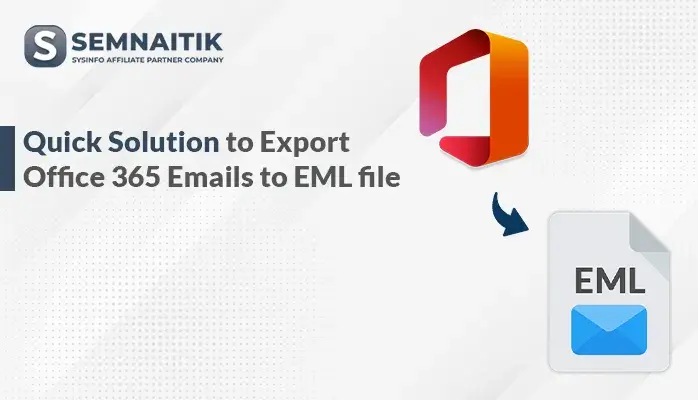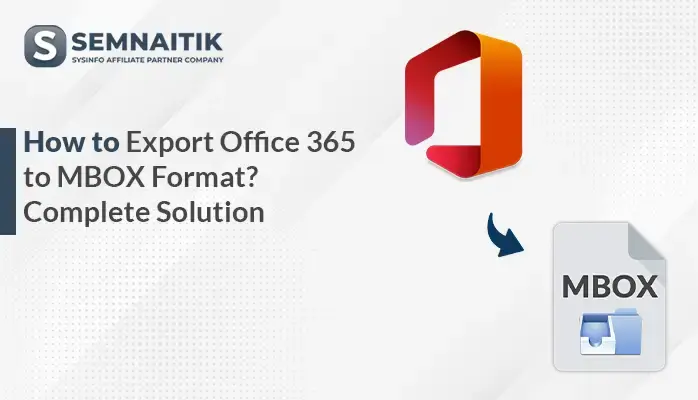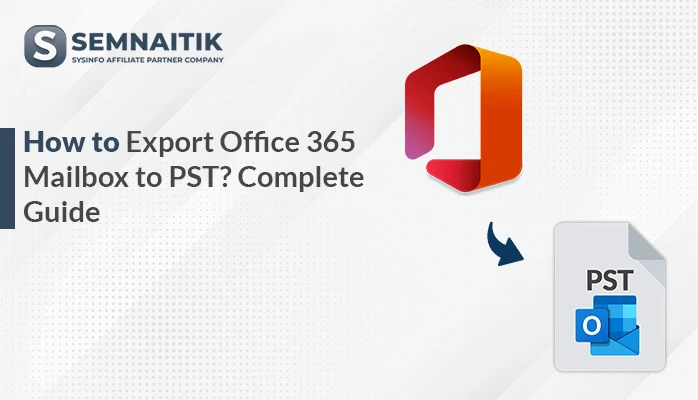-
Written By Amit Chandel
-
Updated on July 17th, 2025
Quick & Easy Solution to Export Office 365 to CSV file
User Query:
“We’re moving to a different system and need to save all our Office 365 contacts, email folders into a CSV file. So I just need a straightforward way to do it without getting stuck in anything too complicated.”
Exporting data from Microsoft 365 looks simple until you try doing it yourself. Whether you’re trying to transfer your contacts, save specific folders, or move data to a new platform, it can quickly get confusing. Although Microsoft provides a few built-in options, they’re not beginner-friendly. So, in this blog, we’ll discuss both manual methods and an expert-recommended SysInfo Office 365 Backup Tool that can easily export Office 365 to CSV.
Why You Should Export Emails from Microsoft 365 to CSV?
CSV files are simple and easy to work with. It opens in tools like Excel or Google Sheets without any difficulty. Exporting your Office 365 emails, contacts, and entries into a CSV can be useful for certain reasons:
- CSV files are great for creating backups or keeping records for compliance.
- Makes it easier to move your data if you’re switching platforms or combining accounts.
- You can sort, search, and filter everything quickly, without needing to go through your inbox.
- It’s handy when you only want to save specific folders or contact groups instead of the whole mailbox.
Different Techniques to Export Office 365 to CSV
There are various ways to export Office 365 data to a CSV file. You can either use the manual methods or go for a professional tool that lets you export emails, contacts, and more with just a few clicks.
Manual Techniques to Transfer Office 365 to CSV Files
If you prefer not to use third-party tools, there are a few manual ways to export data like emails, contacts, and group members. Below are the most commonly used methods with simple step-by-step instructions.
Method 1: Export Office 365 into CSV Through Outlook Desktop
If you just need to transfer a specific folder like your Inbox or Sent Items, Outlook’s built-in export feature works well. Let’s see how it works:
- Firstly, start Outlook and check that your Office 365 account is already set up.
- After that, select File, then go to Open & Export > Import/Export.
- Further, choose Export to a file, then hit Next.
- Later, press Comma-Separated Values (CSV) and select Next again.
- To proceed, choose the email folder you want to export (like Inbox or Drafts), then select Browse to choose where to save it.
- Lastly, give the file a name, select Finish, and Outlook will start exporting the data to CSV.
Note: This method only works well for a single folder at a time and doesn’t include attachments or formatting. If you need to export Office 365 to CSV with full data control, including multiple folders. It’s better to consider using a dedicated solution.
Method 2: Export Contacts From Office 365 to CSV
If you want to save your Office 365 contact list as a CSV file, you can do it using Outlook in very few steps. The steps are as follows:
- Initially, start Outlook, then go to the People or Contacts view.
- Afterward, select File, go to Open & Export, and choose Import/Export.
- Further, select Export to a file, then select Next.
- Later, select Comma-Separated Values (CSV) as the export format.
- To proceed, select your contacts folder linked to the Office 365 account.
- Now, choose the location and file name where you want to save the file.
- Lastly, select Finish. Your contacts will be saved in a CSV format.
Note: You can view the file in Excel to check or clean up the contact data.
Method 3: Export Office 365 to CSV via Admin Centre
If you’re an admin, you can export group member details from Office 365 directly through the Admin Center. It’s a simple way to move member lists into CSV without using any scripts.
- Firstly, go to admin.microsoft.com and log in as an admin.
- After that, select Teams & groups > Active teams & groups from the left menu.
- Now, select the group you want to export.
- Later, open the Members tab to view the list.
- Further, scroll to see that all members are visible.
- To proceed, select Export, or copy the list and paste it into Excel.
- Lastly, save the file as a CSV.
Note: This method only exports member names and emails, not their full mailbox content.
Shortcomings of Manual Methods
- Transferring a large volume of data may take time. Also, it depends on the mailbox size.
- CSV files have row limits, so very large files might be split into multiple files.
- After exporting, review the file in Excel or another spreadsheet tool to check that everything displays correctly.
- It’s always a good option to keep a backup of the original data before making any changes.
Professional Method to Export Office 365 to CSV
If you’re dealing with a large Office 365 mailbox or just want a more efficient way to export your data to CSV. It can be easily done using the Office 365 Backup Tool. The tool makes the entire process easy and lets you choose and preview what to export, like emails, contacts, and more. Hence, you do not need to deal with complicated settings. That makes it a great option for users who want a smooth and trustworthy solution.
Now, follow the steps to complete the process:
- Initially, launch the Office 365 Email Backup Tool and select Backup.
- After that, sign in with your Office 365 credentials; enable Assign Impersonation for multiple accounts.
- Further, choose the desired user IDs and mailbox, then select Next.
- To proceed, preview the mailbox and choose folders to export.
- Then, select CSV as the output format and apply any needed filters.
- Finally, select Backup to start the Office 365 to CSV export.
Explore More: Export Office 365 to MBOX
Conclusion
Manual methods work well with small files. But they’re complex and time-consuming when dealing with large mailboxes. That’s where the Office 365 Converter Tool stands out. The tool is easy to use and has a user-friendly interface. It allows users to choose what to export and save everything to CSV without any difficulty. It is a faster and more reliable way to export Office 365 to CSV, which is why expert recommends using a professional tool.
Frequently Asked Questions
Q. Is it possible to export contacts from Office 365 to CSV?
ANS. Yes, Office 365 contacts can be exported to a CSV file using the Outlook desktop app through the Import/Export feature. For a quicker and more flexible solution, especially when handling multiple accounts or large contact lists. You can use the Office 365 Conversion Tool, which allows you to export contacts, emails, and more directly to CSV with just a few clicks.
Q. Can I export specific folders from Office 365 to a CSV file?
ANS. Yes, you can export specific folders like the Inbox, Sent Items to a CSV file manually using Outlook’s Import/Export feature. But if you need to transfer multiple folders, an expert Office 365 Transfer Tool is the best. It provides an easy and more effective way to transfer selected data directly into CSV format.
About The Author:
Meet Amit, an experienced SEO expert and content planner. He uses his creativity and strategy to create content that grabs attention and helps brands reach their goals. With solid skills in digital marketing and content planning, Amit helps businesses succeed online.
Related Post





